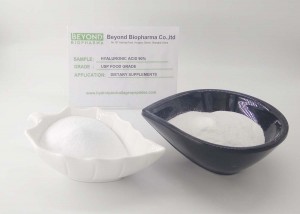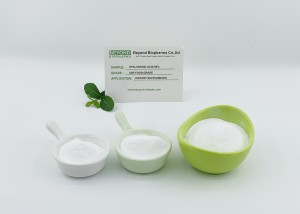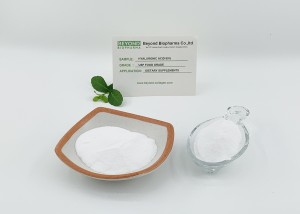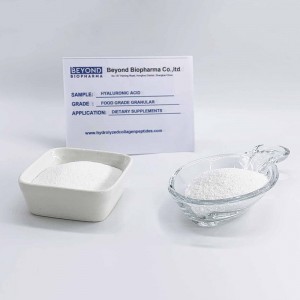Safety Food Grade Hyaluronic Acid Was Extracted by Fermentation
| Material name | Food Grade of Hyaluronic Acid |
| Origin of material | Fermentation origin |
| Color and Appearance | White powder |
| Quality Standard | in house standard |
| Purity of the material | >95% |
| Moisture content | ≤10% (105°for 2hours) |
| Molecular weight | Around 1000 000 Dalton |
| Bulk density | >0.25g/ml as bulk density |
| Solubility | Water Soluble |
| Application | For skin and joint health |
| Shelf Life | 2 years from production date |
| Packing | Inner packing: Sealed Foil bag,1KG/Bag, 5KG/Bag |
| Outer packing: 10kg/Fiber drum, 27drums/pallet |
Hyaluronic Acid is an acidic mucopolysaccharide, a single glycoglycosaminoglycan composed of D-glucuronic acid and N-acetylglucosamine. Hyaluronic acid displays many important physiological functions in the body with its unique molecular structure and physicochemical properties.
Hyaluronic acid is widely found in the extracellular matrix of animal connective tissue, such as human umbilical cord, cockcomb, and bovine eye vitreous. Its molecules contain a large number of carboxyl and hydroxyl groups, can absorb a lot of water, is an important component of skin moisturizing. At the same time, hyaluronic acid also has a strong viscosity, has a wetting and protective effect on joints and eyeball vitreous, and can promote wound healing.
Hyaluronic acid has a wide range of applications. In the medical field, it is used to treat arthritis, eye surgery, and promote trauma healing. In the cosmetics industry, hyaluronic acid is widely used in all kinds of skin care products because of its unique moisturizing function, which can effectively improve the dry skin, reduce wrinkles, and make the skin more smooth, delicate and elastic.
In addition, hyaluronic acid is also divided into different types of macromolecules, medium molecules, small molecules and ultra-low molecules according to its molecular weight size, in order to meet the needs of different application scenarios. Hydrolysis of hyaluronic acid, as a hyaluronic acid molecule with a very low degree of polymerization, is also widely used in certain specific fields because of its unique properties.
| Test Items | Specification | Test Results |
| Appearance | White Powder | White Powder |
| Glucuronic acid, % | ≥44.0 | 46.43 |
| Sodium Hyaluronate, % | ≥91.0% | 95.97% |
| Transparency (0.5% water Solution) | ≥99.0 | 100% |
| pH (0.5% water solution) | 6.8-8.0 | 6.69% |
| Limiting Viscosity, dl/g | Measured value | 16.69 |
| Molecular Weight, Da | Measured value | 0.96X106 |
| Loss on Drying, % | ≤10.0 | 7.81 |
| Residual on Ignition, % | ≤13% | 12.80 |
| Heavy Metal (as pb), ppm | ≤10 | <10 |
| Lead, mg/kg | <0.5 mg/kg | <0.5 mg/kg |
| Arsenic, mg/kg | <0.3 mg/kg | <0.3 mg/kg |
| Bacterial Count, cfu/g | <100 | Conform to the standard |
| Molds&Yeast, cfu/g | <100 | Conform to the standard |
| Staphylococcus aureus | Negative | Negative |
| Pseudomonas aeruginosa | Negative | Negative |
| Conclusion | Up to the standard | |
1. Moisturizing effect: Hyaluronic acid has a strong moisturizing ability, which helps to maintain the moisture of the skin, so as to improve the skin state and make the skin more smooth and elastic.
2. Joint lubrication: hyaluronic acid can lubricate joints, improve joint function, reduce joint wear and tear, and has a certain health care effect for patients with joint diseases.
3. Improve eye health: Hyaluronic acid can increase the water content of the eye mucosa, help to improve the dry eyes, discomfort and other problems, and protect the eye health.
4. Antioxidative and repair: Hyaluronic acid also has a certain antioxidant effect in the body, which can help to remove free radicals, reduce the oxidative stress response, and also help to repair the damaged gastric mucosa and other tissues.
1. Lubrication: hyaluronic acid is the main component of joint synovial fluid, and joint synovial fluid is the basic material to maintain joint function. When the joint is in slow motion (such as normal walking), hyaluronic acid mainly acts as a lubricant, significantly reducing the friction between the joint tissues, protecting the joint cartilage, and reducing the risk of joint wear.
2. Elastic shock absorption: When the joint is in a state of fast movement (such as running or jumping), hyaluronic acid mainly plays the role of elastic shock absorber. It can cushion the impingement of the joint, reducing the impact of the joint, thus reducing the risk of joint injury.
3. Nutrient supply: Hyaluronan also helps to provide the necessary nutrients to the articular cartilage and maintain the healthy and normal function of the articular cartilage. At the same time, it can also promote the discharge of waste in the joint, to keep the joint environment clean and stable.
4. Cell signaling: Hyaluronan also has the function of transmitting cell signals in the joints, participating in the communication and regulation of cells within the joints, and is crucial to maintaining the normal physiological function and structural integrity of the joints.
1. Eye care: Hyaluronic acid is used as a substitute for the eye vitreous in eye surgery to maintain the eye shape and visual effect. In addition, it can also be used to make eye drops to relieve eye dryness and discomfort and provide the necessary lubrication for the eyes.
2. Wound therapy: Hyaluronic acid can improve tissue hydration and enhance the resistance to mechanical damage, so it plays an important role in the wound healing process. It can be applied in trauma dressings or ointments to facilitate faster and more complete wound healing.
3. Skin care products: Hyaluronic acid can be added as a moisturizer and moisturizer to a variety of skin care products, such as face cream, essence, emulsion, etc. Its powerful moisturizing ability helps to maintain the moisture balance of the skin, improve its texture, and make the skin smoother and smoother.
4. Oral care: Hyaluronic acid can be used in oral health products, such as oral spray, toothpaste, etc., to provide oral lubrication and comfort, and help to relieve the discomfort caused by oral ulcers or oral inflammation.
5. Food and beverages: Hyaluronic acid is also added to certain foods and beverages, as a natural thickening agent and moisturizer to improve the taste and texture of products.
6. Biomaterials: Because of their biocompatibility and degradability, hyaluronic acid is also used as a raw material for biomaterials, such as tissue engineering scaffolds, drug carriers, etc.
When hyaluronic acid powder is processed, it can be transformed into several different finished forms, each with its unique properties and uses. Some common finished forms include:
1. Hyaluronic Acid Gel or Cream: Hyaluronic acid powder can be dissolved in water or other solvents to create a viscous gel or cream. This form is commonly used in cosmetic products, such as moisturizers and anti-aging creams, due to its ability to retain moisture and improve skin elasticity.
2. Injectable Fillers: Hyaluronic acid can also be processed into injectable fillers used in aesthetic procedures. These fillers are typically formulated with stabilizers and other additives to enhance their durability and safety for injection into the skin. They are used to smooth wrinkles, enhance facial contours, and correct other cosmetic imperfections.
3. Oral Supplements: Hyaluronic acid powder can be formulated into capsules or tablets as oral supplements. These supplements are often marketed for their potential benefits in improving joint health, skin hydration, and other aspects of overall well-being.
4. Topical Serums and Lotions: Similar to gels and creams, hyaluronic acid powder can be incorporated into topical serums and lotions. These products are applied directly to the skin and are designed to deliver hyaluronic acid's moisturizing and anti-aging benefits.
5. Liquid Solutions: Hyaluronic acid powder can also be dissolved in liquid solutions for various applications, such as ophthalmic solutions for eye lubrication or as a component in surgical irrigation solutions.
Can I have small samples for testing purposes?
1. Free amount of samples: we can provide up to 50 gram of hyaluronic acid free samples for testing purpose. Please pay for the samples if you want more.
2. Freight cost: We usually send the samples via DHL. If you have DHL account, please let us know, we will send via your DHL account.
What are your ways of shipment:
We can ship both by air and be sea, we have necessary safety transportation documents for both air and sea shipment.
What is your standard packing ?
Our standarding packing is 1KG/Foil bag, and 10 foil bags put into one drum. Or we can do customized packing according to your requirements.











